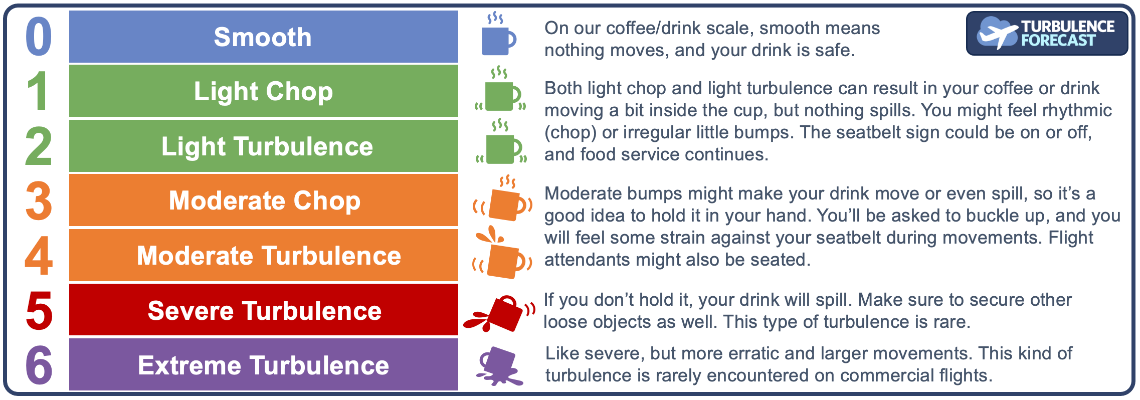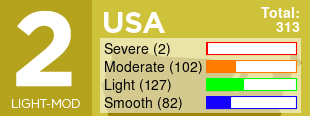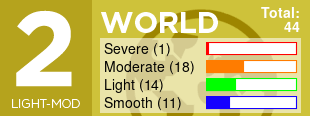Are you an Android developer and love the site? Contact us
updated (Apr 14, 2024)

(c) Turbulence Forecast 2023
How do different levels of turbulence feel in flight?
Updated November 09, 2023
In aviation, turbulence is classified as light, moderate, severe, and extreme. When pilots report turbulence to keep each other informed, it shows up as PIREPs (pilot reports), and forecasters predict the areas of expected turbulence that you see on our charts based on weather forecasting models. While it’s more likely to encounter turbulence in the indicated areas, moments of turbulence can happen at any time during a flight.
How planes and passengers experience these levels depends on a few factors, including the size of the plane and the position of the person in the plane. A small, one-propeller private plane that seats 2 or 4 passengers doesn’t have flexible surfaces that can absorb air movement, so passengers will feel even light turbulence. The same turbulence in a large commercial jet might be imperceptible, as the wings are built to absorb quite a bit of that movement. Passengers seated over the wings and toward the front of the plane feel less movement than those farther back.
However, both small and large planes are absolutely safe to fly through turbulent air. Here is what you might experience during different levels of turbulence on a regular commercial flight on a medium to large size passenger jet, using our “coffee scale:”
However, both small and large planes are absolutely safe to fly through turbulent air. Here is what you might experience during different levels of turbulence on a regular commercial flight on a medium to large size passenger jet, using our “coffee scale:”
- Light: On a large commercial jet, you might not see the seatbelt sign come on, and you might hardly feel any movement. Small bumps might feel like being in a car going over an uneven road. Your coffee will not spill and stay firmly where you put it. In a regional jet or smaller plane, you might be asked to wear your seatbelt, but the overall movement will be small. The crew will continue to serve drinks and food. You might see the wing tips of your plane make small up and down movements.
- Moderate: Your pilot will turn on the seatbelt sign, and you can feel some strain against the seatbelt during larger bumps and movements. It might feel like you’re in an off-roader on an unpaved road. Your coffee won’t fly through the air, but it might wobble, so you should probably hold it in your hand if it’s a full cup. Depending on the type of turbulence, your flight attendants might be asked to stop drink and food service until the air is smoother, to avoid bumping into things or spilling drinks. In some cases, the pilot will ask the crew to sit down as well. The wings of your plane will move up and down, absorbing a lot of the movement of the air and smoothing out your ride.
- Severe: The seatbelt sign is on, and flight attendants have to stay seated and buckled up. During this type of rough air, it’s easy to get bumped into seats or compartments if you are not sitting down with your seatbelt fastened. You will feel a strong strain on your seatbelt, and it might feel like riding bumper cars for a little while. You might feel the plane sway or change altitude rapidly for short moments. Anything that’s lying around might be displaced. Your coffee will definitely not be safe, so drink up! Pilots will usually take measures to slow down if needed, and fly the plane into a different altitude to get out of the turbulent air. It can feel like a lot is happening with the plane, but it will continue to fly safely. You might hear creaking noises, which are normal movements of internal plane components, and suitcases will be displaced, so be careful.
While it can feel uncomfortable, turbulence is a normal part of flying through layers of air. Planes are made to fly through a lot more turbulence than you would ever encounter on a commercial flight.


